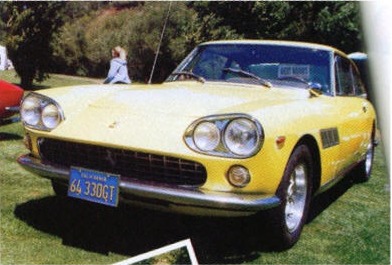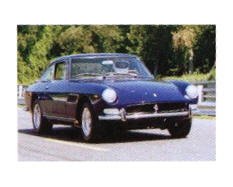 | 330 GT Registry |  |
“Affordable Ferrari”
A Contradiction of Terms?
Everyone deserves to own a machine from Maranello
BY
MIKE COVELLO
PHOTOS BY
THE AUTHOR
For anyone who hits Lotto, it’s a no-brainer to include a Ferrari in the collection. But what about the rest of us who have to earn our money? Don’t we deserve a shot at owning a machine from Maranello?
The good news is that there are Ferraris whose purchase prices have plummeted as low as $18,000 to $50,000. The bad news, as with any exotic car, is beyond that initial purchase price. Heartrending tales of ownership woes are a subcurrent at every car show.
However, they’re also the same people who can steer you in the right direction. Another great place to find prices of used Ferraris is the Ferrari Market Letter (770) 381-1993; www.ferrarimarketletter.com. If you’re looking for published values, go to the “Cars of Particular Interest” (“CPI”) guidebook published by Black Book, (404) 532-4111; www.blackbookusa.com/cpi.asp; or the “NADA Classic, Collectible and Special Interest Car Appraisal Guide and Directory” (www.nada.com).
Perhaps the best advice is to shop first for a knowledgeable mechanic who specializes in the care and feeding of Ferraris. Choose this individual wisely, as you will be getting to know them on a first-name basis. However, contrary to popular belief, Ferraris are not fragile machines. In most instances they are as robustly built as any other vehicles from their era. However, Ferraris are much closer to the “rebuild the engine after every race” end of the scale than the “you can repair anything with a hammer, pliers and a box of oatmeal” Model T simplicity. Once properly tuned, they should provide many years of driving pleasure.
While affordable is a relative term, we decided upon $50,000 as the upper limit. The chosen few can be divided into four groups: V8, V12, European gray market, and imported by Ferrari NA. The V12 cars tend to be more complex, but the melody made by the engine and exhaust are worth the extra lire. The V8 cars are mid-engined and tend to be more nimble. If you pick a model that was never officially imported, make sure that all the applicable DOT and EPA papers have been filed, or your expenses for registering the car might approach the purchase price. Many companies offer classic car insurance that not only pays a stated value for a complete loss but is also typically priced lower than a standard auto policy.
As with any used car, prices can vary by 200% or more based on condition. The prices shown are “CPI”s #3 condition, a car that causal observers might even call excellent. These cars are drivers, sometimes older restorations, and are not 100— point concours cars.
1964-68 Ferrari 330 GT 2+2: You’ll find all V12 listings are for 2+2s. The comparable two-seaters have always sold for a premium in the used market, but the 2+2s offer Ferrari panache and an additional note of practicably. The Series 1 330 GT 2+2 had four headlights, while the cars manufactured after 1965 used a dual-headlight setup that many consider more attractive. Each cylinder compressed roughly 330cc of fuel/air mixture—the 12 totaled 3967cc. Three Weber carburetors and single overhead cams produced 300 bhp. Look to spend around $44,000 for this classic.
 |  |
1968-71 365 GT 2+2: Often referred to as the “Queen Mother” of Ferraris. While the new 612 Scaglietti is longer, at 195 in., this is a big car. The factory listed the weight at 3,483 lb, but reality is probably closer to 4,000. With 365cc per cylinder, the sohc engine was rated at 320 bhp. Expect to pay around $48,000 for this stately automobile.
1971-73 365 GTC/4: When this 2+2 was sold with the 246 Dino and 365 GTB/4 Daytona, it was the most expensive of the trio advertised as the “Last True Ferraris.” (Cars after this were designed while Fiat owned the company.) Despite having four cams and six sidedraft Webers, this model is also rated at 320 bhp.
Some say that the C4 offers the best rendition of the V12 aria. “CPI” lists a #3 at $52,000, but two nice cars sold this year at Barrett-Jackson for $43,740, commission included.
1973-75 365 GT4 2+2, 1977-79 400 GT Coupe, 1980-85 400i GT, 1986-88 412: These four series of cars represent Ferrari’s continuation of the 365 GTC/4 lineage. All are 2+2s with two doors, and they look increasingly like sedans as the series aged. Engine size grew from 4390cc to 4942 cc. The early cars were carbureted, and from 1980 on fuel injection was standard. None of these cars was imported by Ferrari NA, and their values reflect that. The 365 GT 42+2 is listed at $28,700; the 412 fetches closer to $39,500. We cannot stress enough the importance of having the correct DOT and EPA paperwork if you are considering one of these “bargain” V12 Ferraris.
1974-79 308 GT4: While most Ferraris wear bodies designed by Pininfarina, Bertone penned the 308 GT4’s shell. This is just one of the factors that keeps this car near the bottom of the affordable V8 list. This was the first Ferrari designed with U.S. emissions in mind. Like many cars from the mid ‘70s, emissions hardware was still in its infancy and power was lost by reducing compression ratios.
For a few years, this was the only car that U.S. Ferrari dealers had available for sale, yet, initially, it wore the Dino badge, not the Ferrari script. This 2927cc engine was first rated at 240 bhp in U.S. trim with its four Weber carburetors. In May of 1976 the prancing stallion finally adorned the hood. The 1978 Series II engines were rated at 230 bhp, and the 1979 edition had only 205 ponies. This car is sometimes listed in the high teens, and “CPI” says look to pay around $21,000. Many enthusiasts see the 308 GT4 as a great track car.
1976-77 308 GTB, 1978-79 308 GTB/S, 1980-82 308 GTB/Si, 1983-85 GTB/S QV: Now we come to the car that many consider to be the most recognized Ferrari in the world. Credit Tom Selleck’s “Magnum P.I.” with popularizing this Pininfarina-designed beauty. Some would say that the mid-engined V8 lineage has remained unbroken from this model right up to today’s 360 Modena. We list 1976 as a separate entry here, because the first 712 cars were made from fiberglass. At $37,500, these cars get a premium over the 1976-77 $26,600 308 GTBs.
Initially, Ferrari owners objected to being lumped in with Corvettes and other “plastic” cars. Now these cars are considered more desirable due to their slightly lighter weight. The engine was the same as in the 308 GT4; fuel injection was added in the 1980-82 ($28, 575) models, and the 1983-85 ($31,675) 308 QVs (Quattrovalvole) got a pair of four-valve cams per cylinder head.
In 1977 Ferrari unveiled the 308 GTS at Frankfurt. Like the 246 Dino, this model had a lift-off roof that stowed behind the seats. While not a true convertible, many drivers prefer the GTS; and with 3,219 sold between 1977-79, more were purchased than the GTBs. Prices run around $28,275 for the 1978-79 308 GTS, $29,450 for the 1980-82 308 GTSi, and $31,675 for the 1983-85 308 GTS QV.
1986-89 328 GTB/S: Both the bore and stroke were increased in 1986, and the 308 QV begat the 328. Now displacing 3185cc instead of 2927, horsepower also grew from 230 to 260. You can recognize the 328s by their body-colored, more integrated bumpers. You can probably find a 1987 328 GTB for as little as $37,000, and a 328 GTS will poke at the upper dollar limit at $48,600.
1980-1982 Mondial 8 Coupe, 1983-85 Mondial QV Coupe/Cabriolet. 1986-1988 Mondial Coupe/Cabriolet 3.2, 1989-93 Mondial T Coupe/Cabriolet: Introduced in March 1980, the cars were not readily available in the U.S. until 1981. A Cabriolet was offered starting in 1983. This was the first time you could get a Ferrari V8 convertible with 2+2 seating from the factory. This model proved to be more popular than the coupe and continued on until 1993; Ferrari stopped making coupes in 1989.
Using the same 3.0-liter engine as the 308s, the Mondial got the four-valve heads in 1983 for 235 bhp. The Mondial 3.2 of 1986-88 made 260 bhp. Perhaps the best buys on our list are the 1989-93 Mondial T. Besides receiving the same 300-bhp 3405cc engine as the 348 two-seater, the Mondial T had its transmission mounted transversely. This lowered the drivetrain by about 5 in., which had a very positive effect on the car’s handling.
“CPI” says you can pay as little as $22,250 for a 1981 Mondial Coupe. You can shop for a nice 1990 Mondial T Cabriolet ($47,300) and might even find a high-mileage 1993 for less than “CPI”s $58,700 price.
Buona fortuna.
www.europeanarweb.com
Copyright 2004 by PRIMEDIA Specialty Group, Inc.
